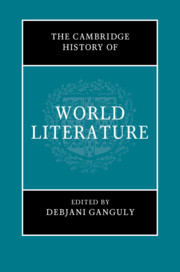Book contents
- The Cambridge History of World Literature
- The Cambridge History of World Literature
- Copyright page
- Contents
- Figures
- Contributors
- Acknowledgements
- Introduction
- Part I Genealogies
- 1 Ancient World Literature
- 2 The Silk Roads of World Literature
- 3 Arabic Literary Prose, Adab Literature, and the Formation of Islamicate Imperial Culture
- 4 Worldmaking and Early Modernity: Cartographic Poesis in Europe and South Asia
- 5 Colonial Philology and the Origins of World Literature
- 6 Globalism’s Prehistory: Technologies of Modernism
- 7 After 1945: Holocaust Memory, Postcoloniality, and World History
- 8 World Literature after 1989: Revolutions in Motion
- Part II Thinking the World
- Part III Transregional Worlding
- Part IV Cartographic Shifts
- Part V World Literature and Translation
- Part VI Poetics, Genre, Intermediality
- Part VII Scales, Polysystems, Canons
- Part VIII Modes of Reading and Circulation
- Part IX The Worldly and the Planetary
- Index
- References
4 - Worldmaking and Early Modernity: Cartographic Poesis in Europe and South Asia
from Part I - Genealogies
Published online by Cambridge University Press: 17 August 2021
- The Cambridge History of World Literature
- The Cambridge History of World Literature
- Copyright page
- Contents
- Figures
- Contributors
- Acknowledgements
- Introduction
- Part I Genealogies
- 1 Ancient World Literature
- 2 The Silk Roads of World Literature
- 3 Arabic Literary Prose, Adab Literature, and the Formation of Islamicate Imperial Culture
- 4 Worldmaking and Early Modernity: Cartographic Poesis in Europe and South Asia
- 5 Colonial Philology and the Origins of World Literature
- 6 Globalism’s Prehistory: Technologies of Modernism
- 7 After 1945: Holocaust Memory, Postcoloniality, and World History
- 8 World Literature after 1989: Revolutions in Motion
- Part II Thinking the World
- Part III Transregional Worlding
- Part IV Cartographic Shifts
- Part V World Literature and Translation
- Part VI Poetics, Genre, Intermediality
- Part VII Scales, Polysystems, Canons
- Part VIII Modes of Reading and Circulation
- Part IX The Worldly and the Planetary
- Index
- References
Summary
This essay develops a literary history of the concept “world” in the early modern period, suggesting that particular literary strategies—speculation, scalar juxtaposition, allegory, philology, and lexical play—became integral to imagining, naming, and shaping a particular vision of “world” across a range of media. Through a comparative study of European and South Asian examples, it shows how worldmaking literature in the early modern period can be characterized by “cartographic poesis,” that is, an intent to shape and represent the idea “world,” to bring it into being as a coherent concept and category. It further explores words for “world” and their significations across a range of languages and cultural contexts, highlighting how literature may be a crucial resource for envisioning ideas of global totality.
- Type
- Chapter
- Information
- The Cambridge History of World Literature , pp. 109 - 131Publisher: Cambridge University PressPrint publication year: 2021



